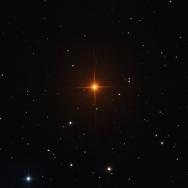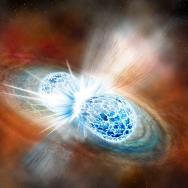The Hubble constant is one of the most important numbers in cosmology because it tells us how fast the universe is expanding, which can be used to determine the age of the universe and its history. It gets its name from UChicago alum Edwin Hubble, who was first to calculate the constant from his measurements of stars in 1929.
Despite nearly a hundred years of astronomical measurements and calculations, scientists still can’t agree on the exact value of the Hubble constant. The true number could reveal missing pieces in our understanding of physics, like new particles or a new form of dark energy.
What is the Hubble constant?
Figuring out the true value of the Hubble constant is one of the greatest challenges in modern astronomy and could revolutionize our understanding of the universe—so scientists at the University of Chicago and many other institutions around the world are trying to pin down the number using multiple methods.
For an astronomical object (e.g. a star or a galaxy) at a known distance from the Earth, the Hubble constant can be used to predict how fast it should be moving away from us.
However, the true value of the Hubble constant remains up for debate. Based on the fundamental physics that scientists believe has driven the evolution of the universe, the Hubble constant should be around 68 km/s/Mpc—but this doesn’t match up to observations of the actual stars and galaxies astronomers see around us.
UChicago astronomer Wendy Freedman led a team that made a landmark measurement in 2001, which found a value of 72. The most recent precise measurements of the distances and movements of distant, exploding stars suggest a Hubble constant of 69.8 km/s/Mpc, but other reports have pushed the value as high as 74 km/s/Mpc.
Although these differences seem small, even a 2 km/s/Mpc discrepancy between predictions from physics and observations implies there could be something major missing from our current understanding of the universe.
How was the Hubble constant discovered?
In the early 1920s, mathematicians used Einstein’s equations for general relativity to predict that the universe should be expanding, but scientists had not yet proven this through observations. At the time, astronomers didn’t even have the observations to settle the Great Debate about the size of the universe; some even argued that the universe did not extend beyond the Milky Way.
Edwin Hubble, a University of Chicago graduate, entered the world of astronomy at this exciting time. While working at California’s Mount Wilson Observatory, Hubble used his extensive telescope experience to make measurements of Cepheid variable stars. Hubble used the work of fellow astronomer Henrietta Leavitt to predict the brightness of these stars, which enabled him to calculate their distances from Earth. Not only did these measurements confirm that the universe extends far beyond the Milky Way, Hubble noticed that more distant stars seemed to be moving away faster.
In 1929, Hubble and colleague Milton Humason used their observations to calculate the mathematical relationship between the distance to a star and the speed at which it is traveling away from the Earth—and thus, the Hubble constant was born. Hubble’s original estimate was 500 km/s/Mpc, or about seven times the value astronomers think it is today.
Generations of astronomers have improved upon Hubble’s original methods and developed new ones, bringing down the Hubble constant to around 70 km/s/Mpc, but there’s still a long way to go. Even though astronomers can now make incredibly precise measurements of many more galaxies and stars, different methods for measuring the Hubble constant still produce disparate results.
How does it work?
Imagine a blueberry muffin. As the muffin bakes and rises, the batter expands, moving all the blueberries apart. If two blueberries enter the oven half an inch away from each other and the batter doubles in size, the distance between them will increase to a full inch. If two blueberries are an inch away from each other before the batter expands, they will be two inches apart once the muffin is baked.
Likewise, distant galaxies moving away faster than nearby galaxies is exactly what we would expect to see in a universe that is expanding everywhere. The Hubble constant tells us the rate at which this is happening.
The expansion of the universe is driven by all the mass, radiation and energy contained within it. The Friedmann equation, derived from Einstein’s famous equations for general relativity, can be used to predict how quickly the universe is expanding mathematically. These equations state that a denser universe expands more quickly, so expansion was fastest when all of the particles in the universe were packed closely together after the Big Bang. Over the past 14 billion years, these particles—and their accompanying energy and radiation—have spread out to vast distances.
We can use the Hubble constant to make a first guess at the age of the universe simply using the equation: speed = distance divided by time. The Hubble constant tells us the speed of an object at any distance, and since the distance between all objects in the universe before any expansion must have been zero, the time in this equation must be the age of the universe. Depending on the value of the Hubble constant, this gives an age of about 14 billion years—not far off the current best-estimate of 13.8 billion years.
However, there’s a slight complication. The speeds of the farthest stars and galaxies that we can observe don’t match what the Hubble constant predicts. Because light from a distant object has traveled for billions of years to reach us, our observations are not only affected by the present-day value of the Hubble constant, but also what it was when the universe was expanding more slowly. In other words, the Hubble constant isn’t a constant at all!
How is the Hubble constant measured?
Currently, there are three main ways to measure the Hubble constant: by using astronomical measurements to look at objects nearby and see how fast they are moving; by using gravitational waves from collisions of black holes or neutron stars; or by measuring the light left over from the Big Bang, known as the cosmic microwave background.
Astronomical measurements
To measure the Hubble constant by observing the universe, astronomers need to be able to measure two things:
- The distance to astronomical objects
- The “recession velocity” of each object (i.e., how fast it is moving away from the observer)
The recession velocity can be measured by taking advantage of a phenomenon called the Doppler effect. A classic example of the Doppler effect is how the sound of a siren changes as an ambulance passes by. This is because the sound waves moving between you and the ambulance are compressed as the ambulance approaches (essentially catching up on its own sound waves), and stretched as it races away.
The same thing can happen to light: The light from stars and galaxies moving away from the Earth is stretched out in the same way as the siren sound from the ambulance, increasing the wavelength of the light. Astronomers call this “redshift.”
To measure the redshift, and therefore the object’s velocity, astronomers look for patterns in the light emitted by stars known as absorption lines. These always occur at the same wavelengths because they are created by the elements in stars’ atmospheres. When redshift changes the wavelength of all the light and absorption lines coming from a distant star, astronomers can measure how much it has shifted to calculate how fast the star is travelling away from us.
Distance to an object is often much more challenging to calculate. For anything beyond our own galaxy, scientists need to know the inherent brightness of the object and compare that to its brightness as viewed from Earth.
“The principle is simple,” said Wendy Freedman, the John and Marion Sullivan University Professor in Astronomy & Astrophysics at UChicago. “Imagine that you are standing near a street light that you know is 10 feet away. At regular intervals down the street you can see more street lights, which get progressively dimmer the further away that they are.
“Knowing how far away and how bright the lamp is beside you, and then measuring how much fainter the more distant lamps appear to be, allows you to estimate the distances to each of the other lamps all down the road.”
This means astronomers can calculate the distance to any objects whose brightness can be predicted; light sources that have been reliably measured are known as “standard candles.” As part of the Hubble Space Telescope Key Project team, Freedman used detailed observations of Cepheid stars to find a value of 72-73 km/s/Mpc.
However, to make an independent estimate of the Hubble constant, Freedman has also pioneered the use of an entirely different kind of star: red giants. Red giants are stars at the end of their lives. Part of their death sequence includes a sudden jump to 100 million degree temperatures in the core of the star, accompanied by a dramatic drop in brightness. From studying nearby red giant stars at known distances, astronomers can measure the maximum brightness of these dying stars. Freedman used this maximum red giant brightness to calculate distances to far galaxies.
Using this new method and others, Freedman’s 2025 measurement of the Hubble constant was 70.4 km/s/Mpc, plus or minus 3%. "This new evidence is suggesting that our Standard Model of the universe is holding up," she said.
Gravitational waves
Gravitational waves are ripples in the fabric of space-time, and they are produced during highly energetic events like neutron star collisions. Scientists can now pick up these waves on Earth using the Laser Interferometer Gravitational-Wave Observatory (LIGO). UChicago Prof. Daniel Holz was the first to suggest that gravitational waves could offer a new way to calculate cosmic distances, coining the term “standard sirens” in a play on “standard candles.”
Astronomers can use the shape of arriving gravitational wave signals to calculate how much energy was released when the two neutron stars collided, and compare this to how much energy the signals are carrying by the time they reach Earth to calculate distance. Holz’s method gives a preliminary value of 70 km/s/Mpc for the Hubble constant, in agreement with Freedman’s most recent work.
Cosmic Microwave Background Radiation modelling
After the Big Bang, the superheating of all the matter in the universe released enormous amounts of radiation as photons. As the universe expanded, this radiation got more and more redshifted. The record of this radiation and redshifting is in the cosmic microwave background.
However, the cosmic microwave background is not uniform; it’s made up of hotter and colder patches that record the “clumpiness” of matter and energy in the very early universe. By combining fundamental physics with estimates of the amount of mass and energy contained within the universe, cosmologists can model the expansion of the universe from its initial state to the present day and reproduce the observed clumpiness in the cosmic microwave background. Cosmologists have repeated this procedure hundreds of thousands of times to find the combinations of conditions that match observations. That includes a measurement of the Hubble constant.
Initial model results seemed to line up with astronomical measurements at around 73 km/s/Mpc, but as observations of the cosmic microwave background got more and more detailed, their estimate has been inching downwards. Using a combination of data from the European Space Agency’s Planck mission, the South Pole Telescope, and the Atacama Cosmology Telescope, scientists in 2025 returned a Hubble constant measurement of only 67.24 km/s/Mpc.
What are possible explanations for the discrepancy?
One possibility is that one or more of the methods to calculate the Hubble constant is flawed. However, the measurements of stars, galaxies, and the cosmic microwave background are incredibly detailed—which means the differences are most likely the result of something much more fundamental than imprecision.
One solution to this conundrum could be dark energy—a mysterious, constant and as yet unobservable background energy that doesn’t spread out even when the universe is expanding. The true value of the Hubble constant could indicate that more dark energy needs to be added to the models of the very young universe to drive its early expansion. This could give scientists new information about the fundamental nature of dark energy and how it has behaved throughout the universe’s history.
Yet another mysterious character that could account for the discrepancy is “dark radiation.” This theory proposes the existence of a new class of subatomic particles (like electrons, neutrinos, and photons), which travel close to the speed of light and zip around the universe, driving its expansion.
To make matters even more complicated, there may not be any extra energy or radiation at all. Dark matter might just interact with the universe in a way that hasn’t yet been built into scientists’ understanding of physics.
What are scientists doing to resolve the Hubble constant mystery?
Scientists are trying to collect more solid evidence to improve each method of calculating the Hubble constant.
Some, including UChicago scientists John Carlstrom, Brad Benson and Jeff McMahon, are working on the next generation of Cosmic Microwave Background telescopes in Antarctica and Chile’s Atacama Desert to check the Planck data and hopefully help calculate an even more precise value for the Hubble constant.
Meanwhile in the astronomers’ corner, Freedman and others are working to take new measurements with different kinds of stars and a technique called gravitational lensing that takes advantage of the enormous mass of galaxies to focus light from celestial objects too far away to see with previous observation methods. And Holz and his colleagues are hoping for more distance measurements from gravitational waves born in neutron star collisions.
Either way, converging on the true value of the Hubble constant is vital for our understanding of the age of the universe and its history.
Last reviewed November 2025.





